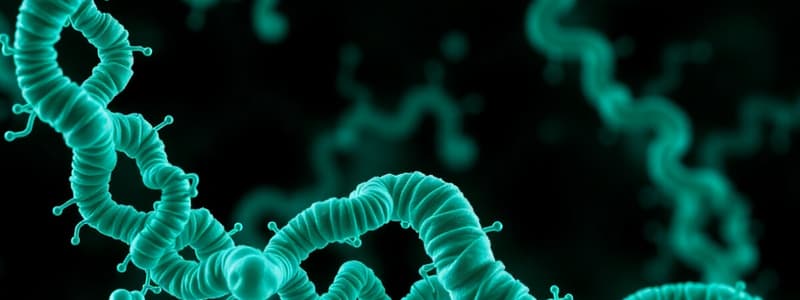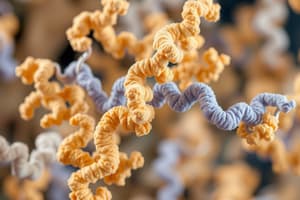Podcast
Questions and Answers
What role does mRNA play in protein synthesis?
What role does mRNA play in protein synthesis?
- It dictates the sequence of amino acids for protein production. (correct)
- It catalyzes the reaction of proteins during synthesis.
- It serves as a receptor for extracellular signals.
- It modifies the structure of membrane proteins directly.
Which class of receptors is characterized by being located on the plasma membrane and includes ion channel receptors?
Which class of receptors is characterized by being located on the plasma membrane and includes ion channel receptors?
- Intracellular receptors
- Plasma receptors (correct)
- G-protein coupled receptors (GPCRs)
- Catalytic receptors
What can the protein produced as a result of mRNA translation function as?
What can the protein produced as a result of mRNA translation function as?
- Only as a structural protein without metabolic impact.
- Only as a membrane receptor.
- An enzyme or a channel affecting physiological processes. (correct)
- Only as an enzyme with no other roles.
In the context of signal transduction mechanisms, what is primarily influenced by the regulation of gene expression?
In the context of signal transduction mechanisms, what is primarily influenced by the regulation of gene expression?
Which of the following is a type of ligand involved in cell-to-cell communication?
Which of the following is a type of ligand involved in cell-to-cell communication?
What characterizes autocrine signaling?
What characterizes autocrine signaling?
Which signaling type specifically involves transmitting signals between nerve cells?
Which signaling type specifically involves transmitting signals between nerve cells?
Which component does the Tyrosine Kinase-Associated receptor lack?
Which component does the Tyrosine Kinase-Associated receptor lack?
In endocrine signaling, what is a key feature regarding the chemical messenger?
In endocrine signaling, what is a key feature regarding the chemical messenger?
What process follows the binding of a ligand to its receptor?
What process follows the binding of a ligand to its receptor?
What initiates the phosphorylation process in Tyrosine Kinase-Associated receptors?
What initiates the phosphorylation process in Tyrosine Kinase-Associated receptors?
Which molecule is responsible for dimerizing with STAT after phosphorylation?
Which molecule is responsible for dimerizing with STAT after phosphorylation?
Which best describes the modulation associated with a single ligand?
Which best describes the modulation associated with a single ligand?
What happens to the ion channel when acetylcholine binds to its receptor?
What happens to the ion channel when acetylcholine binds to its receptor?
Which of the following does NOT mediate transcription through Tyrosine Kinase-Associated receptors?
Which of the following does NOT mediate transcription through Tyrosine Kinase-Associated receptors?
Which of the following is NOT a characteristic of paracrine signaling?
Which of the following is NOT a characteristic of paracrine signaling?
What is the primary function of the JAK family in the context of Tyrosine Kinase-Associated receptors?
What is the primary function of the JAK family in the context of Tyrosine Kinase-Associated receptors?
What is a significant outcome of signal transduction once a ligand binds to its receptor?
What is a significant outcome of signal transduction once a ligand binds to its receptor?
Which type of hormones primarily operate through intracellular receptors, as mentioned in the context?
Which type of hormones primarily operate through intracellular receptors, as mentioned in the context?
What role does STAT play in the signaling pathway associated with Tyrosine Kinase-Associated receptors?
What role does STAT play in the signaling pathway associated with Tyrosine Kinase-Associated receptors?
Which of the following best describes the process after a hormone binds to its receptor in the context of Tyrosine Kinase-Associated receptors?
Which of the following best describes the process after a hormone binds to its receptor in the context of Tyrosine Kinase-Associated receptors?
What is the role of protein kinase A in cell signaling?
What is the role of protein kinase A in cell signaling?
Which G protein is specifically mentioned as being part of the phosphodiesterase pathway?
Which G protein is specifically mentioned as being part of the phosphodiesterase pathway?
What is the main function of cyclic AMP as a secondary messenger?
What is the main function of cyclic AMP as a secondary messenger?
Which of the following is NOT one of the types of secondary messengers mentioned?
Which of the following is NOT one of the types of secondary messengers mentioned?
What determines whether protein kinase A will activate or inhibit a pathway?
What determines whether protein kinase A will activate or inhibit a pathway?
Which component is a product of the phosphoinositide (PIP2) pathway?
Which component is a product of the phosphoinositide (PIP2) pathway?
What initiates the activity of adenyl cyclase and cAMP in cell signaling?
What initiates the activity of adenyl cyclase and cAMP in cell signaling?
Which type of G protein is classified as stimulatory?
Which type of G protein is classified as stimulatory?
What is the role of protein kinase A (PKA) when activated?
What is the role of protein kinase A (PKA) when activated?
How does phospholipase C contribute to physiological responses?
How does phospholipase C contribute to physiological responses?
What is the main function of phospholipase A2?
What is the main function of phospholipase A2?
How is phospholipase C activated?
How is phospholipase C activated?
What is the relationship between calcium and physiological effects?
What is the relationship between calcium and physiological effects?
Which G protein is primarily associated with inhibiting pathways?
Which G protein is primarily associated with inhibiting pathways?
What secondary messenger can be increased by both Gs and phospholipase C pathways?
What secondary messenger can be increased by both Gs and phospholipase C pathways?
Which statement about calcium's role in signaling is true?
Which statement about calcium's role in signaling is true?
Flashcards are hidden until you start studying
Study Notes
Physiologic Response and G Proteins
- Physiologic responses are mediated through G proteins attached to receptors.
- Different types of G proteins include GRPn0 (effect not specified) and GNO (effect not specified).
Protein Kinase A (PKA)
- PKA phosphorylates proteins or enzymes, leading to their activation or inhibition.
- The effect of PKA activation depends on the specific ligand and cell type.
- Activation of PKA influences various metabolic pathways.
Secondary Messengers
- Key secondary messengers include:
- Cyclic AMP (cAMP) and cyclic GMP (cGMP).
- Arachidonic acid metabolites such as prostaglandins and leukotrienes.
- Calcium ions, which serve as secondary messengers, modulating various cellular processes.
Signaling Pathways
- Adenyl Cyclase/cAMP/PKA Pathway:
- Activated by Gs (stimulatory G protein).
Types of Cell Signaling
- Autocrine Signaling:
- The signaling cell also acts as the receiving cell.
- Intracrine Signaling:
- Chemical messengers act within the cell without being released extracellularly.
- Synaptic Signaling:
- Occurs specifically between nerve cells or between a nerve cell and another cell.
- Endocrine Signaling:
- Relies on chemical messengers traveling through the bloodstream to reach target cells.
Signal Modulation
- A single ligand can activate multiple effector proteins, leading to amplified physiological effects.
Receptor Types and Function
- Receptors are crucial for signal transduction, and their interaction with ligands can lead to opening or closing ion channels.
- Example: Acetylcholine binding opens an ion channel, while another G protein may inhibit this process.
Phospholipases and their Role
- Phospholipases (notably A2 and C) hydrolyze phospholipids to release signaling molecules.
- Phospholipase C generates diacylglycerol (DAG) and inositol triphosphate (IP3).
- Calcium levels can be influenced by Gs signaling pathways.
Tyrosine Kinase Signaling
- Tyrosine kinase-associated receptors do not have inherent tyrosine kinase activity; they depend on the activation of Janus Kinase (JAK).
- Upon ligand binding, JAK phosphorylates the receptor, initiating transcription via STAT proteins.
Gene Expression Regulation
- Gene expression is regulated during signaling transduction, affecting both metabolism and cell growth.
- Various ligands and receptor types influence gene expression pathways.
Types of Receptors
- Plasma Receptors:
- Include ion channel receptors, G protein-coupled receptors (GPCRs), and catalytic receptors.
- Intracellular Receptors:
- Include those that respond to steroid and thyroid hormones.
Regulated Intramembrane Proteolysis (RIP)
- Non-classical signaling mechanism involving membrane proteins that can convert extracellular signals into intracellular effects.
Summary Points
- Understand mechanisms of cell-to-cell communication.
- Familiarize with types of ligands and classes of receptors based on location and mechanism.
Studying That Suits You
Use AI to generate personalized quizzes and flashcards to suit your learning preferences.




